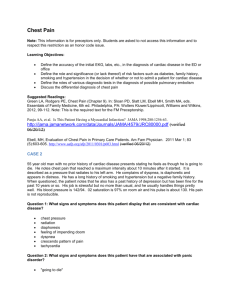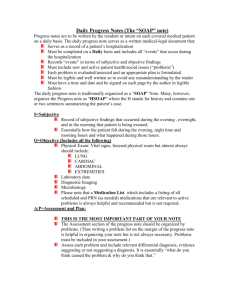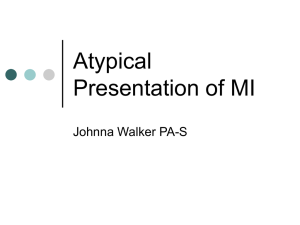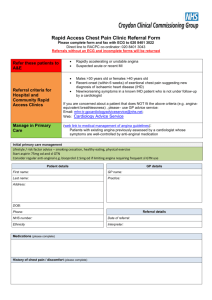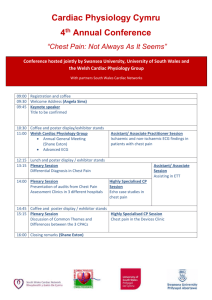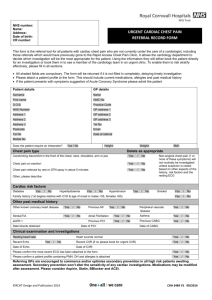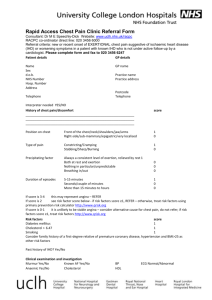Case 1
advertisement
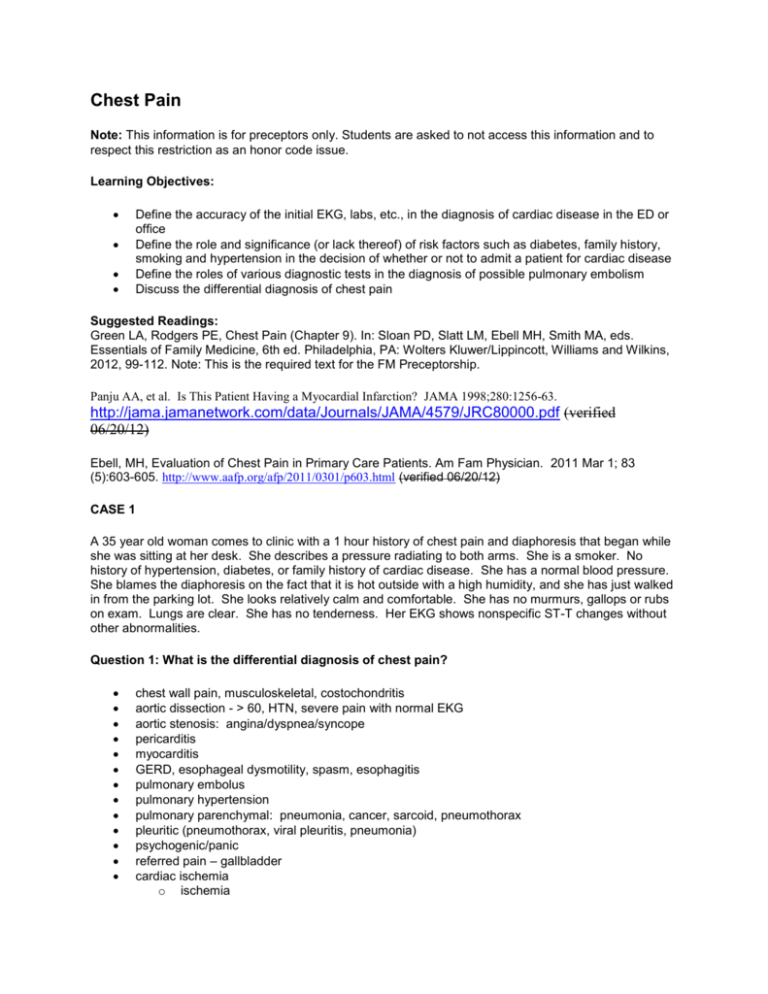
Chest Pain Note: This information is for preceptors only. Students are asked to not access this information and to respect this restriction as an honor code issue. Learning Objectives: Define the accuracy of the initial EKG, labs, etc., in the diagnosis of cardiac disease in the ED or office Define the role and significance (or lack thereof) of risk factors such as diabetes, family history, smoking and hypertension in the decision of whether or not to admit a patient for cardiac disease Define the roles of various diagnostic tests in the diagnosis of possible pulmonary embolism Discuss the differential diagnosis of chest pain Suggested Readings: Green LA, Rodgers PE, Chest Pain (Chapter 9). In: Sloan PD, Slatt LM, Ebell MH, Smith MA, eds. Essentials of Family Medicine, 6th ed. Philadelphia, PA: Wolters Kluwer/Lippincott, Williams and Wilkins, 2012, 99-112. Note: This is the required text for the FM Preceptorship. Panju AA, et al. Is This Patient Having a Myocardial Infarction? JAMA 1998;280:1256-63. http://jama.jamanetwork.com/data/Journals/JAMA/4579/JRC80000.pdf (verified 06/20/12) Ebell, MH, Evaluation of Chest Pain in Primary Care Patients. Am Fam Physician. 2011 Mar 1; 83 (5):603-605. http://www.aafp.org/afp/2011/0301/p603.html (verified 06/20/12) CASE 1 A 35 year old woman comes to clinic with a 1 hour history of chest pain and diaphoresis that began while she was sitting at her desk. She describes a pressure radiating to both arms. She is a smoker. No history of hypertension, diabetes, or family history of cardiac disease. She has a normal blood pressure. She blames the diaphoresis on the fact that it is hot outside with a high humidity, and she has just walked in from the parking lot. She looks relatively calm and comfortable. She has no murmurs, gallops or rubs on exam. Lungs are clear. She has no tenderness. Her EKG shows nonspecific ST-T changes without other abnormalities. Question 1: What is the differential diagnosis of chest pain? chest wall pain, musculoskeletal, costochondritis aortic dissection - > 60, HTN, severe pain with normal EKG aortic stenosis: angina/dyspnea/syncope pericarditis myocarditis GERD, esophageal dysmotility, spasm, esophagitis pulmonary embolus pulmonary hypertension pulmonary parenchymal: pneumonia, cancer, sarcoid, pneumothorax pleuritic (pneumothorax, viral pleuritis, pneumonia) psychogenic/panic referred pain – gallbladder cardiac ischemia o ischemia o o o stable angina acute MI Prinzmetal (variant) angina Question 2: What is the differential of cardiac chest pain? Note: One-third of cardiac patients have no chest pain! stable angina unstable angina acute MI acute coronary syndrome o unstable angina and acute MI acute coronary syndrome = acute coronary syndrome Unstable angina is: rest angina crescendo angina change in angina pattern new angina perioperative angina Question 3: What historical features help you better characterize it as cardiac versus noncardiac chest pain? What is this patient’s risk according to the clinical decision rule in the Ebell article? Assess risk factors (diabetes, hyperlipidemia, family history of premature CAD, smoking, obesity, hypertension) is useful in prevention and long term prediction but are not useful in discriminating cardiac from noncardiac causes in the acute setting. Cardiac Non-cardiac Quality of Pain squeezing, tightness, pressure, sharp/stabbing: - pleuritic or constriction, strangling, burning, heartburn, musculoskeletal, reproducible by palpation: fullness, lump, heavy (elephant) musculoskeletal tearing: aortic dissection Region hard to localize, often left-sided, substernal, localizes pain with one finger or epigastric Radiation radiating to one or both arms not Time and course gradual onset seconds or constant pain sudden and severe - pneumothorax and aortic dissection Provocation exertion swallowing: esophogeal spasm postprandial: GRO stress: anxiety body position: (movement: musculoskeletal, pleuritic, pericarditis breathing: pulmonary or pleuritic Palliation nitroglycerin rest antacids: GI lean-forward position better: pericarditis worse lying down: pleuritic Severity NOT useful NOT useful Associated Symptoms Nausea/vomiting, diaphoresis, dyspnea, syncope cough, chest wall tenderness, palpitations, anxiety/fear This patient would fall into the low risk classification (her pain is not reproducible). Question 4: Which has the highest likelihood ratio of being associated with cardiac disease, right arm radiation, left arm radiation or pain to both arms? Pain may radiate to neck, throat, lower jaw, teeth and upper extremity, shoulder. Wide extension increases odds for chest pain of cardiac origin. Radiation to both arms is a stronger predictor of cardiac chest pain. Question 5: What physical findings increase the likelihood that chest pain is due to a cardiac source? Hypotension - S3 - Pulmonary crackles – Diaphoresis - (Dyspnea is not a strong indicator!) Question 6: What lab tests or other studies do you want to order and how will you use the results in your decision making? Serial EKG – 20% are normal in unstable angina – look for new LBBB, new ST elevation >0.5 mm or ST depression >1 mm in two or more leads, T wave hyperacuity or inversion in two or more leads, or Q waves to indicate acute cardiac ischemia o ST/TW changes – ischemic o ST elevation in V1 – V3 – anteroseptal (LAD) o ST elevation in V4 – V6 – apical/lateral o ST elevation in II, III, AVF – inferior (RCA + LCX) o reciprocal ST ¯ V1 – V3 – posterior o diffuse ST - pericarditis – new LBBB CXR – look for cardiomegaly, pulmonary disease, mediastinal widening, fracture, mass, pneumothorax Serial enzymes o myoglobin o CK MB – low sensitivity till 4-12 h after onset of pain o Troponin sensitive, specific, early rise in MI (within 6 hours) Stress testing o Stress EKG (exercise or pharmacologic) o Thallium (Mi perfusion) o stress echo o angiogram Response to therapy – nitroglycerin can improve pain in cardiac ischemia or esophageal spasm, antacids help in GI causes Question 7: How might women present differently than men? What are special challenges with female patients in the evaluation of chest pain? Women are more likely to have "atypical chest pain" (often pain in the neck, back, or epigastrium). Women and their physicians often don’t recognize these symptoms as cardiac. Women have a high false positive rate on exercise stress testing. Experts recommend using immediate radionuclide imaging or stress echocardiography. Question 8: How might the presentation change for a diabetic patient? An elderly patient? Diabetic patients often feel little or no pain. Elderly patients often have shortness of breath instead of pain. Patients over 65 often have unreliable results on stress ECG testing as well. Question 9: How would you manage this patient? According to the clinical decision rule presented in the Ebell article, this patient should be evaluated for noncardiac causes of chest pain unless there are other reasons for concern. An EKG may have been avoided in this patient, though many physicians would order one anyway. Because this was ordered, it may prompt following the moderate risk pathway with a nonconcerning EKG (serial troponins). This does not add any statistical value to the analysis, but it may help reassure a worried patient or provide opportunities for education about lifestyle modification.

